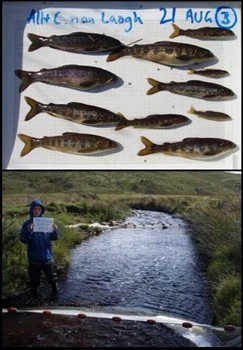How many juvenile salmon can a bouldery riffle support?
Posted: Friday 2 October, 2009 @ 14:32:44

Fishery Trust biologists are frequently asked ‘are there as many juvenile fish as there should be?’ when presenting electro-fishing survey results. To interpret juvenile fish survey data in terms of the health of respective fish populations, knowledge of ‘carrying capacity’ is required.
A project is underway to learn more about the numbers of juvenile salmon that can live in different types of habitat in a series of streams within the upper Conon catchment. In August and September, the WRFT e-fish team has been carrying out fully-quantitative surveys of stream sections which were fully stocked with salmon eggs during the winter 2009.
This project is the first phase of a three year programme which will be delivered by a partnership between the Cromarty Firth Fishery Board & Trust, Fisheries Research Services (John Armstrong), US Forest Service (Keith Nislow), Trondheim University (Sigurd Einum), and Wester Ross Fisheries Trust.
The project builds on work by these partners investigating features of the ecology of salmon that underpin key aspects of their management. This previous research has evaluated the effects of egg dispersal on production (Einum et al., 2008), which is key to the realistic potential for establishing conservation limits; the role of marine-derived nutrients (Nislow et al., 2004), which has fed directly into management of access through hydro schemes, and the potential for increasing production of fish through nutrient restoration (Nislow, et al., 2009; Williams et al., 2009).
Initial work focussed on verifying that the streams in the Conon system respond to nutrients added in the form of salmon kelts. The next stage is to explore the dynamics of nutrient uptake so that workable management methods can be developed to enrich local upland regions with sufficient control to avoid excessive downstream eutrophication (over-enrichment). A further requirement, that has long been recognised, is a clear determination of relationships between local habitat characteristics and production of fish (local carrying capacity). It is intended to establish carrying capacities for habitats within 16 streams in the Cromarty Firth region in year one of the project. In year two it is intended to investigate the possible increase in carrying capacity resulting from nutrient restoration and to characterise features of downstream nutrient spiralling and uptake.
Many thanks to SNH Beinn Eighe NNR's French volunteers and Alex Way for helping with field work; and to Simon McKelvie of Cromarty Firth Fisheries Trust and Dr John Armstrong for setting up the project, and to all estates and keepers for permissions. This project is supported by the Scottish Government via RAFTS.
Reference
WILLIAMS, K. L.; GRIFFITHS, S. W.; NISLOW, K. H.; McKELVEY, S.; ARMSTRONG, J. D. (2009) Response of juvenile Atlantic salmon, Salmo salar, to the introduction of salmon carcasses in upland streams. Fisheries Management & Ecology, Volume 16, Number 4, August 2009, pp. 290-297(8)